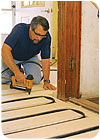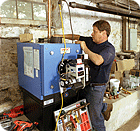"The challenges certainly gave the job some personality," noted Yates. The Martin family lives in a 2,400-square-foot log home dating back to the Revolutionary War. Its stone foundation walls and massive, hand-hewn logs that defy pipe and tubing runs, has been in the Martin family for six generations, and it was about to undergo its first-ever major renovation.

RENOVATION RESEARCH
Radiant heat was at the top of the renovation list, but it wasn't the only renovation Bruce and Heike Martin had in mind. After lengthy research, they specified a compact, high-efficiency boiler; replacement of the fuel oil tank; and the addition of other mechanical system upgrades.Roughly one-half of the home would be involved in the renovation. Fortunately, the basement had a large room for the mechanicals, which were once necessary for the large boiler. Without the boiler there was plenty of room for the new mechanical components.
In another area that served as a cool spot to store the family's potato, onion, and apple harvest, Yates placed one of the radiant manifolds, leaving access for a small staple-up zone underneath the downstairs bathroom.
The home's centrally located, first-floor kitchen would be the focal point of the renovation.
"We all enjoy cooking and food preparation," said Heike. "We'd endured the cold floors long enough."
The kitchen floor was described as ice cold during the winter months. The foundation below it breathed because of the generously ventilated rock foundation.
"This was not by intent," said Bruce. "The old foundation moved here and there over the years, and so the winter winds had relatively free access to the space below."
The only source of heat in the kitchen was a standing radiator, which was replaced earlier in favor of a dishwasher.
Connected to the kitchen is the 100-square-foot laundry room. Its floor would also be heated. Next to it was the downstairs bathroom, soon to be heated by a radiant staple-up from below. "They wanted to pull out a large standing radiator in the bathroom," said Yates. "The challenge was to get enough Btus into the tile floor through a heavy pine subfloor."
Yates used Watts Radiant's RadiantWorks program to determine each room's need for tubing and water temperature based on the design-day temperature of 0°F while plugging-in building specs and construction materials information. "The supplier's heat loss and radiant panel program made the job effortless," he said.
The decision was made to salvage as much of the existing mechanical system as possible. That meant marrying up the new radiant system with the iron piping that joined other hydronic lines within the home.
This also presented a slight design challenge because of the heating curve for the several remaining radiators, and the typical need to reset system temperatures based on outdoor ambient temperatures. Yates planned to run these as one high-temperature zone.
ROCK QUARRY CHALLENGES
While making the heat load calculations, the kitchen became an interesting challenge. The room was a bit troublesome because of its location above the "rock quarry," Bruce's favorite description of a centuries-old pit, filled with rocks, rubble, old timbers, glass, and pottery shards. The floor of the kitchen would be suspended above the pit. Its underfloor was inaccessible. "Even if we did have access to it, it was too rough for crawl space work," said Yates. He immediately set his sights on SubRay, a product made by Watts Radiant."SubRay delivers a lot of heat at very low operating temperatures," said Yates. "Connecting panels are simply screwed to the top of the subfloor and the tubing weaves between them; it delivers up to 40 Btu per square foot. We've used SubRay for many different jobs, even a multitiered, octagonal timber-framed home, so we're familiar with its versatility and performance."
The remodeling contractor sealed the stone foundation and heavily insulated the underfloor of the kitchen using R23 insulation. Since the laundry room also needed heat and would become an extension of the ceramic tile surface that the Martins had chosen for the kitchen, Yates chose to extend the SubRay into that area as well, placing both on the same thermostatic zone.
The bathroom staple-up offered a new challenge. Unevenly spaced joists were running in one direction above a very narrow access area, and the drain and water lines were running in another direction. Yates found the Watts Radiant's EPDM radiant tubing, Onix, to be the solution.
"In a space where PEX would have been virtually impossible to install, the Onix tubing was easily woven around all the obstacles, including a number of protruding nails that had been used to hold down the concrete board under the finished ceramic tile floor above," said Yates.

THE RIGHT EQUIPMENT
The homeowners selected an oil-fired Laars "Max" boiler and its partner, a 40-gallon DuraFlow indirect-fired hot water heater for the domestic water needs. The boiler is a low mass, direct-vent unit with a two-pass cylindrical heat exchanger that delivers about 87 percent efficiency. According to Yates, the new boiler would use up to 60 percent less fuel than the old one while retaining 40 percent of the heat previously lost to the chimney and occupying a quarter of the space necessary for the old unit." ‘Balanced flue' for the sidewall venting is Laars' term for direct venting of the Max boiler," said Yates. "It's a quick and easy connection with stainless steel lines between the boiler's exhaust and outdoor air and the termination box where the incoming air passes over the outgoing, inner stainless steel piping - this prewarms the incoming air. A flue draft regulator is needed when using this kit."
The Laars DuraFlow indirect-fired water heater replaced the 15-year-old, freestanding electric unit.
"With multiple zones, the indirect's load was not factored into the total load for sizing the boiler. Setting up an indirect on a priority zone in a radiantly heated home works well because of the minimal loss of heat to comfort zones while the system idles and allows the full power of the boiler to quickly regenerate the domestic tank," noted Yates.
The control panel itself was another task.
"Rather than building one, we chose to provide the design specs to Watts Radiant," noted Yates. "This job was ideally suited to fabrication of a small, simple HydroControl panel, made by their experts and shipped to the jobsite with the SubRay, tubing, manifolds, and other materials.
"The panel," said Yates, "is the heart of any radiant system, and it sets the tone for how all of its parts will operate. We needed to provide a multiple-temperature system from a single temperature source. We had two high temperature zones - the indirect hot water tank and the remaining cast iron radiators - and two lower-temperature zones for the staple-up lower bath and kitchen, both with SubRay."
BUDGET REALITIES
"We sure had some fun playing with the panel's design," said Yates. "Budget was a real concern, so simple mixing strategies were needed. We reduced pumps and mixing valves by running higher-temperature water through the staple-up floors first and using that two-loop manifold's return flow to feed the lower temps required by the SubRay in the kitchen and laundry room. It returned to the boiler from there, essentially as an extended, single loop. The flow rates were low enough to support the strategy.""As with any system we install," Yates said, "we try to keep it simple and cost effective. The fewer bells and whistles, the fewer long-term maintenance issues. Designing things right at this stage is a critical issue. To save some bucks, the owner chipped in too. After we cut off the boiler piping, Bruce completely dismantled it and removed every trace of it."
As the job neared completion, two new 275-gallon oil tanks were delivered by Highland Tank. The new 12-gauge, twinned ToughTanks, with fuel lines joined at their bottom outlet, were piped to the exterior with full-sized fill and vent lines.
"There's a fair amount of concern lately about high pressure pumping (permitting faster delivery of fuel) and tanks having crossover lines becoming over-pressurized," said Yates. "Considering this, I felt the extra time and materials were warranted. With each tank having its own vent alarm to signal when to stop pumping oil, there's now minimal chance of a spill or rupture."
The Martins were also highly satisfied when the two fuel oil tanks were topped off after four months. "The tanks were filled with less than 250 gallons," they said. "It provided super efficient heat for the entire house during a severe winter, all of our hot water for showers, baths, and laundry and with way less oil than we've consumed before."
Flipping through a tablet with notes about the job, Yates rattled off a few remaining notes about the mechanical system: The indirect hot water storage tank is equipped with an aquastat governing the relay that energizes the boiler.
A separate manifold served the SubRay. This zone's operating temperature was set for a range of 137° to 85°F, with a 20° drop during the initial run through the staple-up zone. The 20° drop in temperature provides the proper reset temperature ratio for the SubRay zones, which follow in series.
All components received isolation valves. The system was a bit more costly up front, but greatly valuable in years to come if the mechanical components require service.
"We made it through our first winter in the newly remodeled house," said Bruce. "There's really no way to describe the feeling of comfort when it's so raw outside, the snow's piled up, and we wake up to a warm home with warm floors. It's pretty remarkable."
Publication date: 10/16/2006

Report Abusive Comment